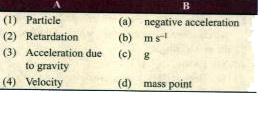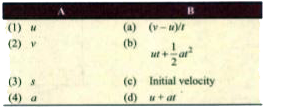CONSOLIDATED EXERCISE (MULTIPLE-CHOICE QUESTIONS WITH ONE OR MORE THAN ONE CORRECT ANSWER) from CENGAGE PHYSICS DESCRIPTION OF MOTION for Class 9
| Class 9 | PHYSICS |
| Chapter | DESCRIPTION OF MOTION |
| CENGAGE PHYSICS | CONSOLIDATED EXERCISE (MULTIPLE-CHOICE QUESTIONS WITH ONE OR MORE THAN ONE CORRECT ANSWER) |
| Medium | English |
| Academic Year | 2023-2024 |
Question 1
A particle moves along the X-axis. Its X-coordinate varies with time according to the expression x=4t+2r2, where x is in meters and t is in seconds. The position-time graph for this motion is shown in the figures previously. Note that the particle moves in the negative X-direction for the first second of motion, is at rest at the moment t=1s, and then heads back in the positive X-direction for t>1s.
Find the displacement of the particle in the time interval t=0 s to t=1 s. View SolutionQuestion 2
A particle moves along the X-axis. Its X-coordinate varies with time according to the expression x=4t+2r2, where x is in metres and t is in seconds. The position-time graph for this motion is shown in the figures previously. Note that the particle moves in the negative X-direction for the first second of motion, is at rest at the moment t=1s, and then heads back in the positive X-direction for t>1s.
What is the average velocity of the particle in the time interval t=0 s to t=1 s? View SolutionQuestion 3
A particle moves along the X-axis. Its X-coordinate varies with time according to the expression x=4t+2r2, where x is in meters and t is in seconds. The position-time graph for this motion is shown in the figures previously. Note that the particle moves in the negative X-direction for the first second of motion, is at rest at the moment t=1s, and then heads back in the positive X-direction for t>1s.
Find the displacement of the particle in the time interval t=1sto t=3s. View SolutionQuestion 4
A particle moves along the X-axis. Its X-coordinate varies with time according to the expression x=4t+2r2, where x is in meters and t is in seconds. The position-time graph for this motion is shown in the figures previously. Note that the particle moves in the negative X-direction for the first second of motion, is at rest at the moment t=1s, and then heads back in the positive X-direction for t>1s.
What is the average velocity of the particle in the time interval t=1s to t=3s?View SolutionQuestion 5
A particle moves along the X-axis. Its X-coordinate varies with time according to the expression x=4t+2r2, where x is in meters and t is in seconds. The position-time graph for this motion is shown in the figures previously. Note that the particle moves in the negative X-direction for the first second of motion, is at rest at the moment t=1s, and then heads back in the positive X-direction for t>1s.
Find the instantaneous velocity of the particle at t=2.5s.View Solution
All Exercises from CENGAGE PHYSICS Class 9 PHYSICS DESCRIPTION OF MOTION
- MANDATORY EXERCISE (EXERCISE SET - I)
- MANDATORY EXERCISE (EXERCISE SET - II)
- MANDATORY EXERCISE (EXERCISE SET - III)
- CONSOLIDATED EXERCISE (COMPREHENSION)
- CONSOLIDATED EXERCISE (MATCH THE COLUMNS)
- CONSOLIDATED EXERCISE (MULTIPLE-CHOICE QUESTIONS WITH ONE CORRECT ANSWER)
- CONSOLIDATED EXERCISE (MULTIPLE-CHOICE QUESTIONS WITH ONE OR MORE THAN ONE CORRECT ANSWER)
- CHALLENGING EXERCISE
- OLYMPIAD AND NTSE LEVEL EXERCISE
- WORKED EXAMPLES




